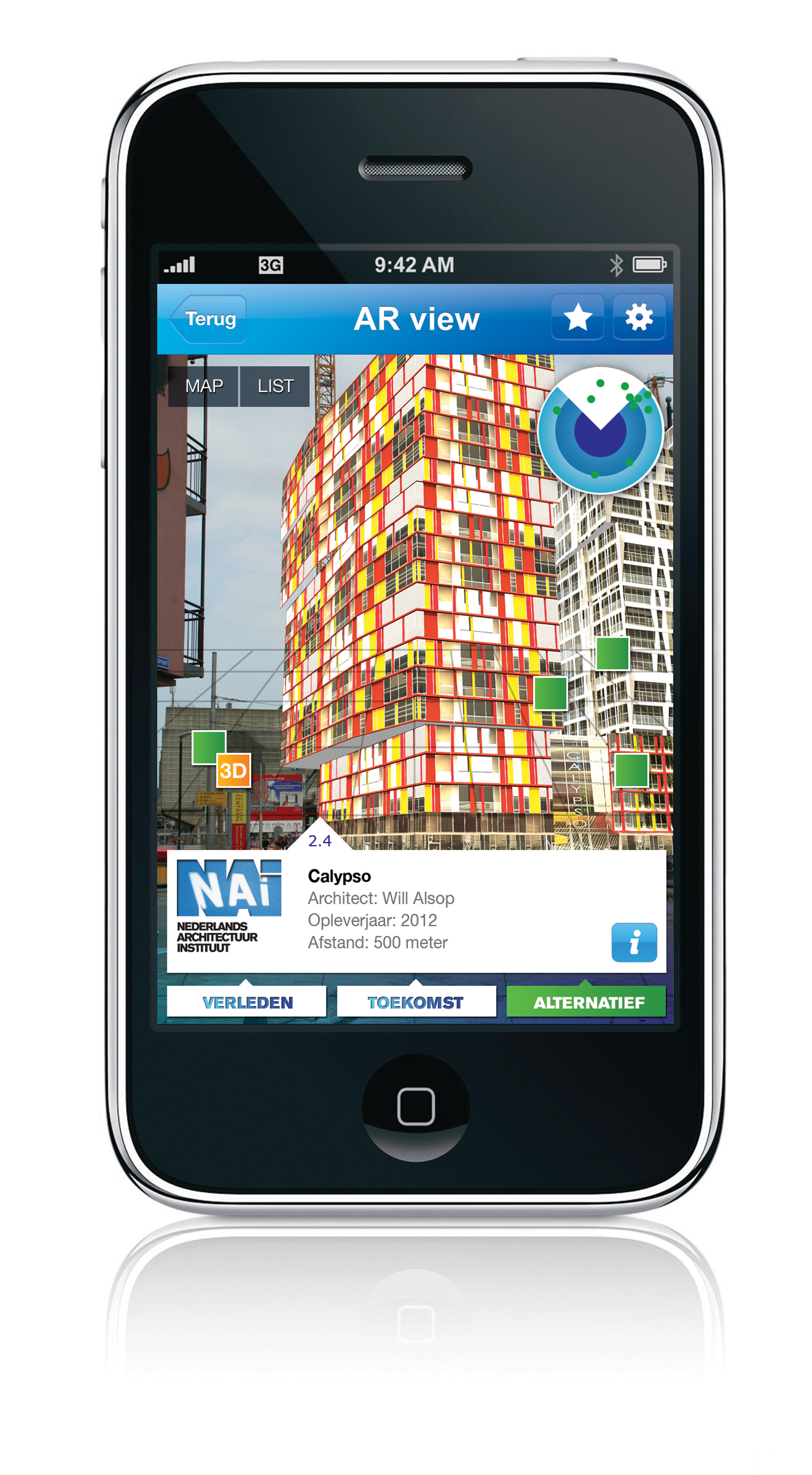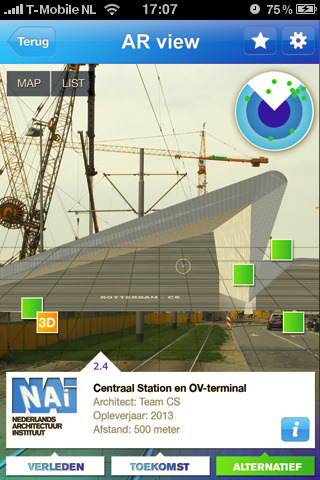Some time ago, Jacco Ouwerkerk contacted me having seen the interview I did with the Museum of London. He directed me towards a hugely exciting Augmented Reality application called UAR – “Urban Augmented Reality” which launched in the Netherlands in June 2010.
Here’s what we talked about.
Q: Please introduce yourself, and tell us about your involvement with the project
I’m Jacco Ouwerkerk, interactive concepter at IN10 Communication, a creative agency that creates interactive brand, museum and city communication. I’ve been responsible for developing ‘open museum concepts’ like Urban Augmented Reality (UAR) for the Netherlands Architecture institute (NAi). The Netherlands Architecture Institute is a museum, archive, library and platform that wants to get people of all ages involved in architecture.

I’ve been working on the UAR project since the start in 2009 and I’m responsible for the concept development, interaction design and the project management.
Q: What is the project / what does it do?
Urban Augmented Reality (UAR) is the world’s first mobile architecture application featuring augmented reality and 3D models. With UAR you can see the past and the future (things that aren’t even there yet..) of the built environment on your iPhone and Android smartphone. The NAi has set itself an incredible challenge by making the Netherlands the first country in the world to have its entire architecture viewable in augmented reality.
Rotterdam is the first city that is available in UAR. Rotterdam is famous for its modern architecture, but let’s not forget the past. Rotterdam doesn’t have many historical architecture left due to the bombardment during WWII, but the UAR makes it all visible again. UAR makes it able to see alternative designs of buildings in their real environment. Or get a sneak preview on the new Rotterdam Central Station.
Later this year Amsterdam, Utrecht and The Hague will follow.
Q: You chose Augmented Reality as your technology of choice. Can you tell us how you went about making this choice, and why you think it works best for you?
Mid 2009 Ferry Piekart, curator UAR from NAi, invited us for a brainstorm meeting at the NAi. He wanted us to come up with an idea how they could be a museum outside the museum walls. This is because architecture is best experienced in and around the architecture itself. Also, NAi will be closed for months because of construction activities. Therefore there had to be an alternative for NAi to share its enormous collection to the public.
At that moment I was thesis supervisor of Maurice Melchers on the subject of Augmented Reality. We were looking for relevant Augmented Reality concepts that could surpass the more gimmicky concepts that we found on the internet at that time. We concluded that AR could very well be used to view architecture.
In june 2009 we started researching the possibilities of AR on the smartphone in combination with interactive tours. At the same time Layar launched their Augmented Reality browser. We contacted them and soon we started a partnership to develop the Urban Augmented Reality application with 3D models. There was a lot of enthusiasm among the participants in this project: NAi, Layar and IN10.
Q: Tell us about the process you went through to build the app?
Our goal was to develop a stand-alone (native) smartphone application that could be accessed by as many people as possible. We chose to develop an application for the iPhone and the Android platform, in our opinion the two most relevant platforms to launch our application on. After researching the possibilities we came to the conclusion that we had to develop a web based app to make it easier to show content on both platforms, (multi platform) in stand alone apps. The content is also available in the Layar browser.
Our main goal was to create a maximal user experience: easy to use, with relevant information and optimised mobile content. User experience design for Augmented Reality is new. For the AR view we had to design with the Layar AR possibilities but also added some features. For example; a switch between the different stages of AR: past and present. At the same point we got the feeling we were finally designing our childhood dream: a time machine!
In the application you get all sorts of extra information about architectural projects, architect biographies, sketches, drawings, environments and an overview of the process of the realisation of the projects. The NAi spent lots of time selecting projects out of world’s largest architecture collection and preparing texts and images ready for a mobile context.
With UAR we tried to bring the ideas and stories in architecture to life by adding audio tours within themes and special ‘famous’ guides who tell you about the buildings surrounding you. This feature will be available in the upcoming update.
Testing UAR was surreal! We spent hours wandering in the city of Rotterdam looking through mobile phones: sometimes the spots were very crowded. People tend to get a little paranoid when they think you point a mobile phone in their direction. The technology is new so we had to deal with GPS accuracies caused by electricity cables, buses driving by and so on. We also spent a lot of time finding the right angle and GEO codes combination for 3D building positioning.
Q: What provision is there for people who don’t have these phones, and how did you go about making the choice to be selective with your audience?
It’s the first time mobile Augmented Reality is accessible on this scale. Augmented Reality only works on smartphones with compass and GPS receiver. We know not everybody has a smartphone and had several discussions how we could make UAR accessible for as many people as possible. We have choosen a multiplatform approach where we make the content available on stand-alone apps (for free) and via Layar browser. The Netherlands Architecture Institute wants to be innovative and decided to start with AR because of the relevancy of AR for architecture and in the belief that in the coming years everybody will have a smartphone.
Q: How successful has the app been?
The app has been downloaded approximately 2500 (iPhone/Android) times. Within the Layar browser UAR has been requested more the 6500 times.
Q: Can you give us some detail about the technical implementation of the app?
There were a lot of people and parties involved: NAi, IN10 (responsible for the concept, design, project management, CMS), Layar (SDK and browser), Triangle Studios (app development) DPI Animation House (3D models) and the Rotterdam Historical Archives.
Together we worked on getting the archive accessible in UAR on all kind of levels. We used the Content Management System to collect and upload the complete (selection of the) archive of NAi (materials, texts and 3D models made by DPI).
We imported a great amount of data by using Excel! For future releases, editors of the NAi, urban archives and architects can upload and create content directly in the CMS themselves. We’re also going to use all kinds of API’s and connect various collections and archive databases in UAR.
Q: What have you learnt about mobile / AR / developing this kind of thing? What might you do the same / differently in the future?
The biggest challenges we faced and learnings we have experienced during this process were the mobile multi-platform development, pre-loaded content, database connections/imports/API and 3D positioning.
I hope we get together with other museums and institutes to join forces on mobile development. I’ve seen that there are so many archives and collections that are digitalised. Together we can create strong mobile user experiences.
Q: What have you got planned for the future?
Rotterdam is the first city, to be followed later this year by Amsterdam, Utrecht and The Hague. The rest of the Netherlands will follow in 2011. We’re also planning to add user generated content to the application.
Q: Anything we’ve missed…?
Smartphones with AR, QR and image recognition are just the catalyst of a future where everything will be connected with data. It’s more important than ever to open up and join forces to create beautiful, interactive and meaningful museum environments in and outside the museum.
It’s time to tell data stories to augment the reality of our daily lives.


Comments are closed.